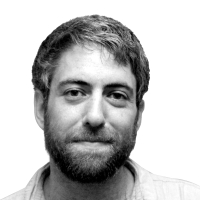GAZA CITY — In devastated Gaza the wounded, the displaced and many of the dead are accounted for, but there is no organized search for the missing.
In the makeshift refugee camp behind Shifa hospital distraught family members go between the hospital, the handful of representatives from Gaza police, and the health ministry searching for relatives who’ve disappeared. There are no offices that act as clearinghouses where they might find those lost in the chaos of Israeli bombs and Hamas guerrilla warfare. The hospital—which has become the only sign of any social service and civil bureaucracy left in Gaza—doesn’t even have a list for people who want to register the missing or a roster describing the unidentified dead and wounded.
When I ask hospital representatives for an estimate of how many people have disappeared since the fighting started July 8, they tell me to speak with the health ministry, which in turn passes me off to the police. Then Azmi al Kaishawi, from government media relations, tells me that the war has crippled Gaza’s civil service and I should check with local non-governmental organizations.
“The government isn’t functioning properly, no one is in the offices,” says al Kaishawi. Workers stay away from government buildings because they are Israeli targets. “People come to Shifa, but it’s not designed to handle these things,” he says.
Unforunately, the NGOs and the aid agencies of the United Nations and foreign governments in Gaza are focused on coping with what they already know for certain: over 1,800 people killed, nearly 10,000 wounded and a quarter of the 1.8 million people in Gaza displaced. The mystery of hundreds of disappeared men, women and children will have to wait.
The International Committee of the Red Cross has no overall numbers of missing people and says that it is incredibly difficult to gather such information. According to an ICRC official, who isn’t authorized to speak to the press and asked not to be named, the aid agency relies on the Israelis notifying it about people captured or taken to Israel for medical treatment, the Hamas government to tell it about the dead, and individual families to report missing people that they then try to connect. But the system is so full of gaps and flaws it can hardly be called a system at all.
A few days ago I began talking with members of the Al Jamal family, who are living in the Shifa camp and who’ve been searching desperately since July 20 for 12-year-old Osman Raid Al Jamal. They believed he might have been killed in an Israeli airstrike, but no one had seen his body, nobody could be sure he was dead, and as with so many tragic disappearances, uncertain hope only compounded the pain of imagined loss.
“We have gone to the police and the hospital and they have plenty of cases like this but will not be able to deal with them until after the war,” Osman’s uncle, Rami al Jamal, told me as in the tiny hospital park that’s been turned into a refuge of multicolored tents and tarps for those who fled the demolition of the Shajaya neighborhood between Gaza City and the border of Israel.
Rami kneels on a thin foam mattress next to another of Osman’s uncles, Aram Hellis, as they try to explain what happened. They were running down the street just as a bomb exploded. Three members of the family were killed in the explosion but Osman, the fourth, could not be found.
Three days later a boy was pulled from the rubble during what was supposed to be a temporary ceasefire. The face was disfigured, the flesh decaying. The two uncles had to try to determine from the clothes whether the body belonged to Osman or not, and they decided, finally, that it did not.
Ever since, they have been run in circles as they try to locate Osman. Rami says the family has reported the boy’s disappearance and the circumstances to the Red Cross but was told if he wasn’t found by the end of the war, the ICRC would just count him among the dead.
Osman’s father, Mohammad, has been broken by the days, now the weeks, going back to the neighborhood where whole streets have been turned to dust and shards, then to the networks of chaotic camps where a stunned or injured Osman might have found his way, then to the hospital, and to the morgue piled with bodies, and back to the neighborhood, a carousel of horror and loss.
“Osman’s father won’t give up until his son is found,” Rami told me. In a place starved for resources and facing constant new crises as fighting, punctuated by tenuous ceasefires, drags on, the Jamal family—like an unknown number of others—was on its own searching for a lost child.
And then, on Sunday, on yet another visit to the morgue, Osman’s father looked blankly into a refrigerator full of corpses and suddenly saw among them a piece of fabric that looked like something he remembered Osman wearing. The boy’s body had been there since the day he died, but nobody had been willing or able to help the family find him. In a society barely able to comprehend what it has already seen, once again, imagined hope gave way to certain loss.




